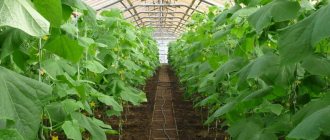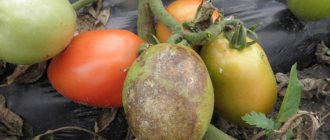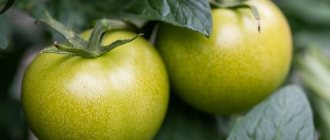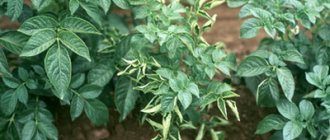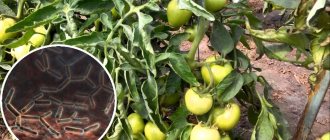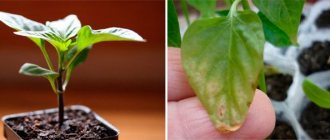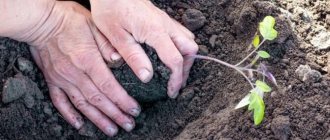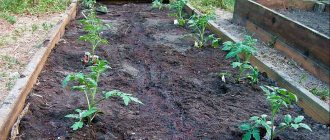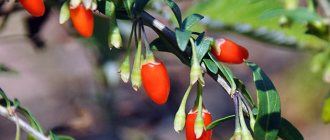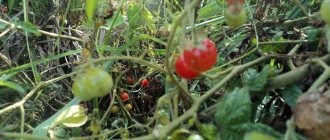In order for the tomato harvest to be good, and the fruits and the plant themselves to be healthy, you need to carefully care for the plant “from the cradle” - that is, from the seedling stage. It is during this period that the foundation of a healthy, viable culture is laid. But it often happens that tomatoes begin to lose flowers and ovaries overnight. Why this happens and how to prevent this phenomenon, we will consider further. Moreover, there may be several unfavorable factors, and in order to correct the situation correctly, it is necessary to understand all possible reasons.
Increased soil moisture
Tomatoes are self-fertile plant crops. Insects are not needed at all for the formation of the ovary. When barren flowers appear or there is no flowering at all, you should first check the soil moisture.
In conditions of excess moisture, pollen acquires increased adhesion and sticks together, no longer participating in the formation of the ovary. A number of preventive measures when flowers fall off on tomatoes:
- In greenhouse conditions, it is necessary to install sensors that will allow you to control the level of air humidity.
- Regular ventilation will reduce the concentration of saturated water vapor in the air.
- In open ground, it is necessary to mulch the soil immediately after planting seedlings.
Loosening and preliminary creation of a good drainage layer will preserve flowers on tomatoes.
How to spray tomatoes in a greenhouse to prevent flowers from falling off
Boric acid
If you notice that the branches of your tomatoes have begun to fall off, boron fertilizing will serve as first aid. Boric acid is a stimulator of ovary formation, reduces the incidence of plant diseases and increases yield.
To prepare it, you need to gradually stir 10 g of the substance (1 sachet) in 1 liter of hot water (not boiling water!). Stir continuously until the powder dissolves completely. Then the solution is brought to a volume of 10 liters. Spray the plant with a freshly prepared solution in the morning or evening. Or during the day, in cloudy weather, but not in rainy weather. When spraying, ensure uniform wetting of the leaves. The consumption of the working solution should be up to 10 liters per 100 square meters. m.
What are the benefits of using boric acid for tomatoes?
- More fruit is set;
- Stimulates the formation of new growth points of stems and roots;
- Increases the sugar content of fruits;
- Reduces the likelihood of diseases occurring in plants caused by boron deficiency.
Tomaton
It is a fruit formation stimulator. It is made from natural germ substances, so its use does not adversely affect plants. The active stimulating substance is auxin, obtained synthetically.
As a result of using Tomaton, fruit set improves, yield increases by 30-40%, and fruits begin to ripen 7-10 days faster. In addition, the fruits are sugary and tasty.
It is very easy and convenient to use the product. A 1 ml ampoule of the product is dissolved in 0.5 liters of water, 2 drops of liquid soap are added to it, the mixture is shaken well. For spraying, choose a brush where the flowers have fully or half opened. Only flower brushes are sprayed. Just one treatment is enough.
How to use Tomaton is described in the video, watch it.
High air temperature
Another unfavorable climatic factor for flowering seedlings. When the air temperature rises above 35 degrees, pollen loses its properties (such pollen is called sterile). A number of preventive measures:
- Regular ventilation of the greenhouse.
- Curtaining the sunny side with special shading nets.
- Planting seedlings near doorways and transoms, where moderate drafts form.
In open ground conditions, plants are planted either in shaded areas, or special nets are used to create shade.
Irrational crop care
The basis for high-quality growth, flowering and fruiting of any vegetable crop is proper care, which includes watering, applying fertilizers and fertilizing, maintaining temperature balance and air humidity levels.
The causes of impaired growth and falling of flowers can be a sharp cold snap or temperature change, lack of moisture in the soil or prolonged rains, or a violation of soil acidity.
Upon careful examination, you will notice that the flower on the plant is deformed (the stigma of the pistil protrudes beyond the stamen, making pollination of the plant impossible). Prevention of such situations lies in organizing optimal care for vegetable crops.
Useful tips
In addition to the above activities, there are several secrets to achieve higher tomato yields in greenhouses.
Here are some of them:
- It is better to orient the beds in the greenhouse from east to west, this way the bushes are provided with optimal lighting.
- The soil in the garden bed needs to be mulched. This allows you to better retain moisture in the soil, while preventing the air from becoming waterlogged. You can use hay or grass clippings as mulch.
- It is advisable to water tomatoes using a drip irrigation system, with the drip tubes placed on top of the mulch, and not under it.
- At the moment of intensive root growth, tomato bushes need to be hilled. The moment is chosen when characteristic seals appear in the lower part of the trunk (for the first time) and when the stem in this place acquires a purple tint (for the second time). It is very important to use moist soil for hilling.
- In order for the set fruits to ripen faster, after the ovary has formed, experienced gardeners carefully pinch the top of the bush, and then gradually, over the course of several days, remove almost all the foliage from the tomato, leaving almost one bare trunk and fruit clusters.
- When the tomatoes on the bush reach the desired size, you can help them reach ripeness and turn red faster by stopping or severely limiting watering. Feeding is also not carried out during such a drought.
- Extra early varieties of tomatoes are placed in the corners of the greenhouse. In this case, as the mid-season and late varieties grow, the early bushes can be removed, and they will not shade the main bed.
- After harvesting and removing the bushes from the garden bed, the soil should be carefully loosened, but deep digging, accompanied by mixing of soil layers, should not be carried out.
- Tomato tops collected from the garden should not be thrown away. Tomatoes grow well on their own leftovers. In order to provide them with this opportunity, the tops are cut into small fragments and embedded in the ground at the same time as loosening. Over the winter, much of the residue will rot and create the best organic fertilizer you can think of.
Drying of flowers in tomatoes growing in a greenhouse is a problem that occurs quite often. Despite this, any experienced gardener will confirm that a truly good tomato harvest can only be obtained by growing the crop under film. If you approach the issue responsibly and take into account all the nuances, then the shedding of flowers in tomatoes can easily be avoided, and in this case the achieved result will meet all expectations and even exceed them.
Deficiency of mineral components
Another possible reason why flowers on tomatoes fall off is a lack of minerals. Micro- and macroelements are indispensable participants in the metabolism of all vegetable crops.
They promote the active growth of the root system and ground parts, including the flower. Some minerals promote leaf growth and timely ripening of fruits. Particular reasons why tomato flowers fall off are:
- Severe deficiency of phosphorus and potassium. At the same time, it should be remembered that potassium cannot be absorbed at too low a temperature.
- Excess nitrogen in the soil or imbalance between potassium, phosphorus and nitrogen. This condition can be recognized by the appearance of a yellow color of the flower followed by the fall of the ovary.
- Deficiency of boron and manganese. The reason may be either the lack of appropriate fertilizing or alkaline soils (when the acidity level increases, these microelements are not absorbed by the plant).
All phosphorus fertilizers are applied to the soil before seedlings are planted, and additional fertilizing is carried out periodically during active growth. Potassium fertilizing can be applied from the very beginning of flowering.
To compensate for the deficiency of minerals (boron and manganese), industrial compounds or a solution of boric acid are used, which are diluted strictly according to the instructions.
Prevention
Preventive measures consist of correct and timely implementation of agrotechnical work - fertilization, watering, loosening the soil, etc. When growing in greenhouses, sanitation of the premises and soil is required to prevent the formation of stable pathogenic microflora. It will be very difficult to fight her later. Ventilation of the tent is also necessary - it is necessary for fresh air and access for bees to pollinated plants.
For all plants without exception, proper pinching and planting of seedlings in the ground is necessary, observing the frequency of rows and avoiding crowding. In order for indoor seedlings to better adapt to open ground, a few days before planting, boxes with seedlings should be taken outside for several hours in warm, sunny weather.
If a barren flower is detected, such flowers must be removed so that the bush can redistribute its forces for the growth of normal ovaries.
Proper care of tomato beds, including watering, fertilizing, and combating pathogenic environments, will protect tomatoes from falling flowers. It is not too late to fight for the harvest at any stage of detecting this problem. Such measures will help save the harvest and become a good preventive measure.
Improper bush care
In addition to mineral deficiency and suboptimal care, there are a number of other reasons why the ovary on tomatoes falls off:
- Use of fertilizers and growth stimulants for the ground part. Excessive growth of the stem and leaves in the absence of sufficient growth of the root system leads to the gradual falling off of flowers.
- Untimely removal of barren flowers from the branches of the bush.
- Leaving a large number of additional stepsons on the bush.
All these reasons lead to insufficient nutrition of the apical leaves and flowers. Preventive measures include removing excess shoots, barren flowers, and tearing off the lower leaves.
Infectious diseases of tomatoes
Not only defects in care and lack of minerals can cause tomato flowers to fall off. Almost all pathogens of infectious diseases of tomatoes can directly or indirectly lead to the fall of the ovaries on the bush.
There are specific symptoms that indicate damage to the plant by one or another pathogen of a bacterial, viral or fungal nature.
Early introduction of a pathogenic parasite leads to a decrease in plant immunity, as well as to the rapid addition of secondary infections.
As a result of damage to tomato tissue, the growth and flowering of the bush is disrupted. Prevention measures include timely detection of signs of the disease, removal of affected bushes and treatment of healthy plants.
Why do tomatoes (tomatoes) in a greenhouse lose color without opening?
Now let's figure out why pollen has lost all its qualities. And what should be the necessary conditions for fruit set.
- Temperature regime . In order for the pollen to ripen and fruit to set, it is important to maintain the temperature regime in the greenhouse. If the temperature is below +15ºС, not all fruits will set. At temperatures below +10ºС, fruits will not set at all. At temperatures above +35ºС, pollen often becomes sterile. Night temperature should not be higher than +20ºС. The fact is that tomatoes must “rest” at night, and if these conditions are not met, even fruit formation stimulants will not help in hot weather.
- Air humidity . High humidity promotes pollen gluing; it simply cannot spill out of the anthers. When humidity is low, pollen cannot fully ripen. The optimal air humidity at which fruit sets well is 40-70%.
- Incorrect watering . Tomatoes are drought-resistant plants. But despite this, they need regular and sufficient watering. But plants also do not like excessive soil moisture; this happens on heavy and clay soils.
- Lack of nutrition during budding and flowering. If 6-8 flowers have formed on one brush, and the plant lacks the necessary microelements and enzymes, only 2-3 will set, and the remaining ovaries will fall off. Plants, as intended by nature, regulate this process themselves, because if there is a lack of nutrition, they cannot stretch out all the ovaries.
- Excess nitrogen. If tomatoes are overfed with nitrogen fertilizers, they will become “fatten”, they will have fleshy tops and thick stems. And such a bush blooms sluggishly and reluctantly. There are few flowers, and they often fall off. Sometimes gardeners make the opposite mistake and do not add nitrogen to the plants. Underfed plants are sluggish in growing the first cluster. Their stems are stunted and thin, and they are reluctant to set fruit on 2-3 clusters.
Other reasons for flower falling:
- overloading the bushes with fruits,
- strong wind,
- cloudy weather - lack of light and sun,
- Excessive application of lime, which slows down the absorption of a microelement such as boron.
If you adhere to all the listed conditions for growing tomatoes, then you will not have any influence on the setting of plants. For example, shaking bushes. The plant will set itself up beautifully.
